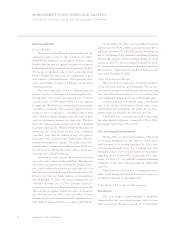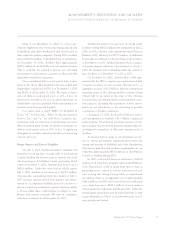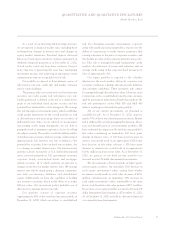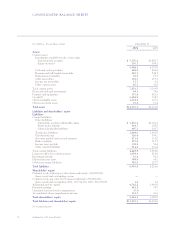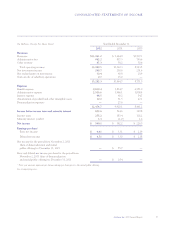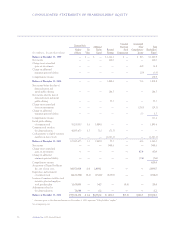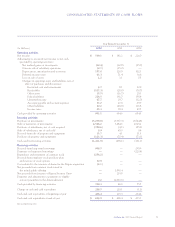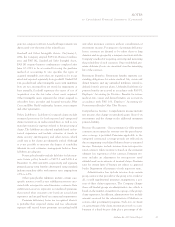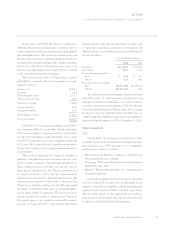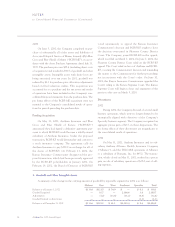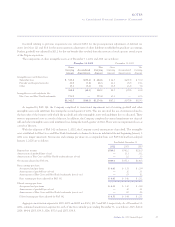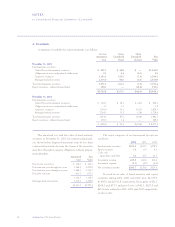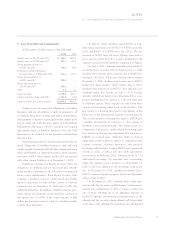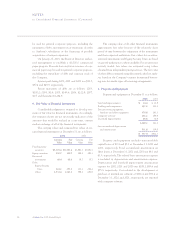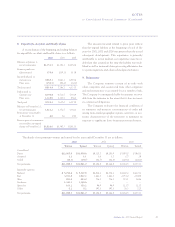Anthem Blue Cross 2002 Annual Report Download - page 65
Download and view the complete annual report
Please find page 65 of the 2002 Anthem Blue Cross annual report below. You can navigate through the pages in the report by either clicking on the pages listed below, or by using the keyword search tool below to find specific information within the annual report.
NOTES
to Consolidated Financial Statements
60 Anthem, Inc. 2002 Annual Report
December 31, 2002 (Dollars in Millions, Except Share Data)
1. Basis of Presentation and
Significant Accounting Policies
Basis of Presentation: On November 2, 2001, Anthem
Insurance Companies, Inc. (“Anthem Insurance”) con-
verted from a mutual insurance company to a stock insur-
ance company in a process known as a demutualization.
Concurrent with the demutualization, Anthem Insurance
became a wholly owned subsidiary of Anthem, Inc.
(“Anthem”), and Anthem completed an initial public
offering of common stock. The demutualization was
accounted for as a reorganization using the historical car-
rying values of the assets and liabilities of Anthem
Insurance. Accordingly, immediately following the demu-
tualization and the initial public offering, Anthem
Insurance’s policyholders’ surplus was reclassified to par
value of common stock and additional paid in capital.
The accompanying consolidated financial state-
ments of Anthem and its subsidiaries (collectively, the
“Company”) have been prepared in conformity with
accounting principles generally accepted in the United
States. All significant intercompany accounts and trans-
actions have been eliminated in consolidation. The
Company is licensed in all 50 states and is the Blue Cross
Blue Shield Association licensee in Indiana, Kentucky,
Ohio, Connecticut, New Hampshire, Maine, Colorado,
Nevada, and Virginia (excluding the Northern Virginia
suburbs of Washington, D.C.). Products include health
and group life insurance, managed health care, pharmacy
benefit management and government health program
administration.
Minority interest represents other shareholders’ interests
in subsidiaries which are majority-owned by the Company.
Use of Estimates: Preparation of the consolidated
financial statements requires management to make esti-
mates and assumptions that affect the amounts reported
in the consolidated financial statements and accompany-
ing notes. Actual results could differ from those estimates.
Investments: All fixed maturity and equity securities are
classified as “available-for-sale” securities and are reported
at fair value. The Company has determined that all
investments in its portfolio are available to support cur-
rent operations and, accordingly, has classified such
investment securities as current assets. The unrealized
gains or losses on these securities are included in accumu-
lated other comprehensive income as a separate compo-
nent of shareholders’ equity unless the decline in value is
deemed to be other than temporary, in which case the
loss is charged to income.
Realized gains or losses, determined by specific iden-
tification of investments sold, are included in income.
Cash Equivalents: All highly liquid investments with
maturities of three months or less when purchased are
classified as cash equivalents.
Premium and Self-Funded Receivables: Premium and
self-funded receivables include the uncollected amounts
from insured and self-funded groups, less an allowance for
doubtful accounts of $29.5 and $32.6 at December 31,
2002 and 2001, respectively.
Reinsurance Receivables: Reinsurance receivables rep-
resent amounts recoverable on claims paid or incurred
and are estimated in a manner consistent with the liabili-
ties associated with the reinsured policies. There was no
allowance for uncollectible reinsurance receivables at
December 31, 2002 and 2001.
Other Receivables: Other receivables include amounts
for interest earned on investments, proceeds due from
brokers on investment trades, government programs,
pharmacy sales, claim recoveries and other miscellaneous
amounts due to the Company. These receivables have
been reduced by an allowance for uncollectible amounts
of $20.4 and $23.2 at December 31, 2002 and 2001,
respectively.
Restricted Cash and Investments: Restricted cash and
investments represent fiduciary amounts held under trust
arrangements used for future obligations under certain
unfunded benefit plans and are reported at fair value.
Property and Equipment: Property and equipment is
recorded at cost. Certain costs related to the development
or purchase of internal-use software are capitalized in
accordance with AICPA Statement of Position 98-1,
Accounting for the Costs of Computer Software Developed or
Obtained for Internal Use. Depreciation is computed prin-
cipally by the straight-line method over estimated useful
lives ranging from 15 to 39 years for buildings, three to
seven years for furniture and equipment, and three to ten


